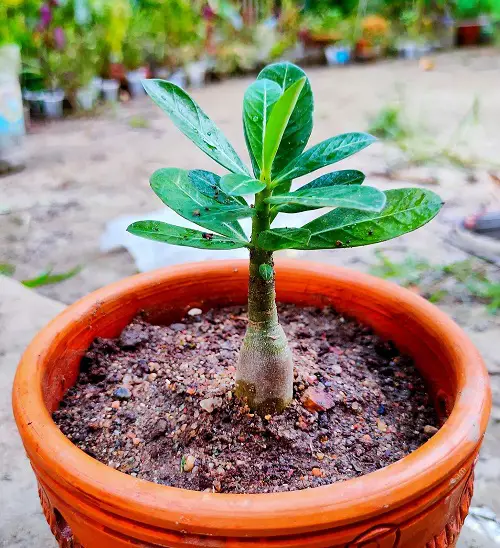Here’s the complete guide that covers Everything About Growing Plumeria in Pots! Seriously, you won’t need anything else.

If you’ve been searching for colorful flowers that are simple and pretty but can also fill up your lawn with a sweet fragrance, don’t look further than Plumerias. They’re low maintenance, last long, and thrive in warmth. Here’s Everything About Growing Plumeria in Pots!
Plumeria Plant Information
Plumerias are flowering plants that are native to tropical regions in the Americas. They are great ornamental plants with large, showy flowers that come in white, yellow, pink, red, and orange colors. They are cherished for their strong fragrance, which is just as good as that of jasmine and citrus plants.
Plumerias thrive in warm climates and can be grown both indoors and outdoors. If you ask us, they’re perfect for pots.
Best Pot Size for Growing Plumeria in Containers
Let’s start with the pot. Plumerias need an 8-10 inch pot to grow. Pick one that’s this deep and wide, and start growing your Plumeria in it. Once it fills the pot, you can transplant it into one that’s 2-3 inches bigger.
So how big do Plumeria get in pots? Plumerias are medium-sized plants and can easily reach 4-8 feet in pots. You can go with pruning, but it’ll grow back over time.
Best Plumeria Varieties for Pots
We recommend going with compact or dwarf Plumerias because their size is easier to manage for container growing. You should look for Dwarf Watermelon, Penang Peach, Dwark Pink Singapore, and Thailand Red varieites. They’re easy to find at local nurseries and garden centers. Plus, they look amazing in pots.
Propagating Plumeria in Pots
You can grow Plumerias in pots from cuttings and seeds but you should go with the former. Seeds take much longer to grow and cuttings are easier to work with anyway.
Just get an 8-10 inch long cutting and let the cut end callous for a couple of days. After that, you only need to stick it in a pot and keep the pot in indirect light after misting it. The cutting will root in a few weeks and then grow into a beautiful Plumeria. Easy peasy, right?
Requirements for Growing Plumeria in Pots
Location
Plumerias need plenty of sun to grow, so make sure you place the pot in a spot that gets at least 6 hours of full sun every day. Inside, a south-facing window would do.
Soil
Growing your Plumeria in a pot will be a breeze if you choose the right soil. For this, gather the following things and create a mix.
- 2 parts potting soil for base
- 2 parts perlite for drainage and aeration
- 1 part orchid bark for air pockets
Do wear a mask when handling perlite to avoid inhaling dust particles.
Water
Just make sure the top 2-3 inches of the soil are dry before you soak your plumeria in a pot. This will work for both indoor and outdoor Plumerias, but with indoor ones, it might take a couple of extra days for the soil to dry up. So check the topsoil with your finger.
Temperature and Humidity
Plumeria plants prefer daytime temperatures between 70°F and 90°F (21°C and 32°C) for the best growth. They can tolerate temperatures as low as 50°F (10°C), but you will need to protect them from frost or freezing temperatures.
These flowers generally prefer moderate to high humidity levels, about 50% – 70%.
Plumeria Care in Pots

Fertilizer
Pick a fertilizer that is rich in phosphorus. A fertilizer with an NPK of 10-30-10 is great for Plumerias in pots, but don’t give it directly; dilute it in water to 1/4 its strength and only feed it to your plants once in 6-8 weeks.
Pruning
Plumerias don’t grow too big but if you feel like your Plumeria needs a trim, go for it. Just make clean cuts and try to do it just before the growing season (late winter, early spring) so the plant’s health does not suffer.
Pests and Diseases
Your Plumerias might be affected by aphids or mealybugs, but you can take care of these with a spray made with neem oil. Also, don’t overwater your plant because the roots will rot, and slowly, your plant will start to decay.







But how do you get them to flower ? I have been growing in pots in south-facing conservatory for many years, in the U.K. giving tomato feed , pricking growing tips, still only very rarely flower